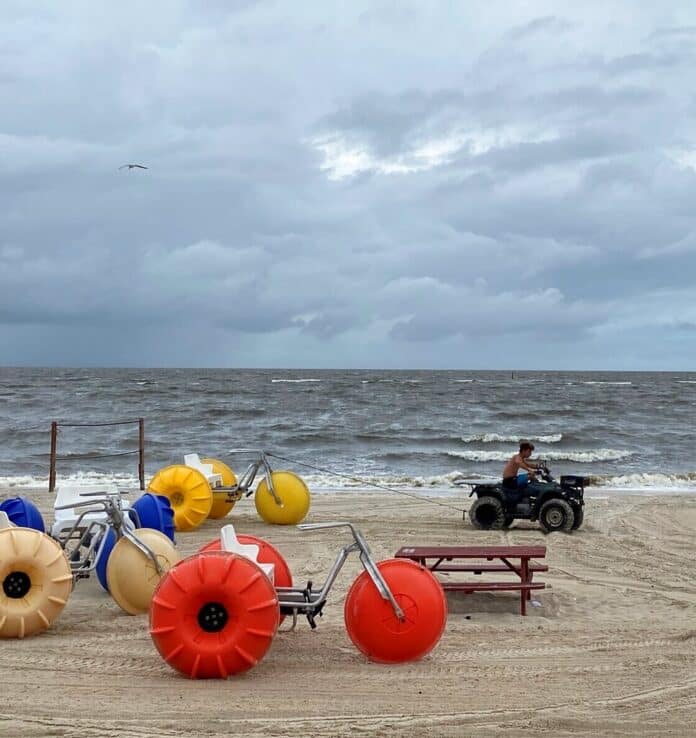
By KEVIN McGILL and JEFF MARTIN | Associated Press
NEW ORLEANS (AP) — A disorganized storm system carrying tropical storm-force winds churned through the Gulf of Mexico toward the Southern U.S. on Friday, lashing coastal communities with bands of rain, threatening flash flooding and forcing the postponement of Juneteenth celebrations in Mississippi and Alabama.
Forecasters said the system was moving north over the Gulf of Mexico packing maximum sustained winds of 45 mph (72 kph), which is above the tropical storm threshold of 39 mph (63 kph). It hadn’t been designated a tropical storm as of Monday afternoon because it lacked a single, well defined center, said Benjamin Schott, meteorologist in charge at the National Weather Service office in Slidell, Louisiana.
The looming weather threatened Father’s Day tourism in an area already suffering economic losses caused by the coronavirus pandemic.
A tropical storm warning was in effect for parts of Louisiana, Mississippi, Alabama and Florida — extending from Morgan City, Louisiana, to the Okaloosa-Walton County line in the Florida Panhandle. Flash flood watches extended along the coast from southeast Louisiana into the Florida panhandle and well inland into Mississippi, Alabama and western Georgia.
“I hope it just gets in and gets out,” said Greg Paddie, manager of Tacky Jack’s, a restaurant at Alabama’s Orange Beach.
In Mobile, Alabama, Ryan Schumann, president of the Alabama Deep Fishing Rodeo on nearby Dauphin Island, could at least take solace in the fact that the event is scheduled for next month, not this weekend.
But disappointment was evident in the voice of Seneca Hampton, an organizer of the Juneteenth Freedom Festival in Gautier, on the Mississippi Gulf Coast. He spent weeks arranging food trucks, vendors, a bounce house, face painting and free hamburgers and hotdogs for the event, which was highly anticipated because last year’s was canceled due to the pandemic and because of Juneteenth’s new designation as a federal holiday.
“It’s something that means a lot to people, and there were people that were bummed out, like ‘I already had in my mind I was coming out there to celebrate,'” said Hampton.
The Gautier event was postponed until next month. A Juneteenth event in Selma, Alabama, was postponed until August.
By midday Friday, brisk winds and bands of rain were hitting the coast from south of New Orleans to Pensacola, Florida. An afternoon advisory from the National Hurricane Center said the system was about 165 miles (266 kilometers) south of Morgan City, Louisiana and was moving north at 14 mph (22 kph).
In Louisiana’s vulnerable Plaquemines Parish, the local government warned mariners that locks and a floodgate in the Empire community, near where the Mississippi River meets the Gulf, would close at noon. Health officials ordered oyster harvesting areas closed along much of Louisiana’s coast. Storms can push pollutants into oyster beds and officials often suspend harvests amid tropical weather until water quality can be tested after the storm.
Louisiana Gov. John Bel Edwards issued a state of emergency late Thursday. The move is an administrative step that authorizes the use of state resources to aid in storm response efforts.
Forecasters said the system could produced up to 12 inches (30 centimeters) through the weekend along the central U.S. Gulf Coast.
The combination of storm surge and the tide will cause normally dry areas near the coast to be flooded by rising waters moving inland from the shoreline, the hurricane center said. The water could reach heights of about 1-3 feet (30-91 centimeters).
In Orange Beach, Paddie said Tacky Jack’s still has sandbags left over from its preparations for last year’s Hurricane Sally. That September storm, blamed for two deaths, threw ships onto dry land, knocked out power to hundreds of thousands of people in Alabama and in the Florida panhandle.
There have already been two named storms during the 2021 Atlantic hurricane season. Meteorologists expect the season to be busy, but not as crazy as the record-breaking 2020 season.
Mexico, while getting rain from the storm in the Gulf, was also threatened by a storm in the Pacific. Tropical Storm Dolores formed Friday morning and was expected to make landfall on Mexico’s west-central coast Saturday evening, possibly near hurricane strength, according to the National Hurricane Center.




